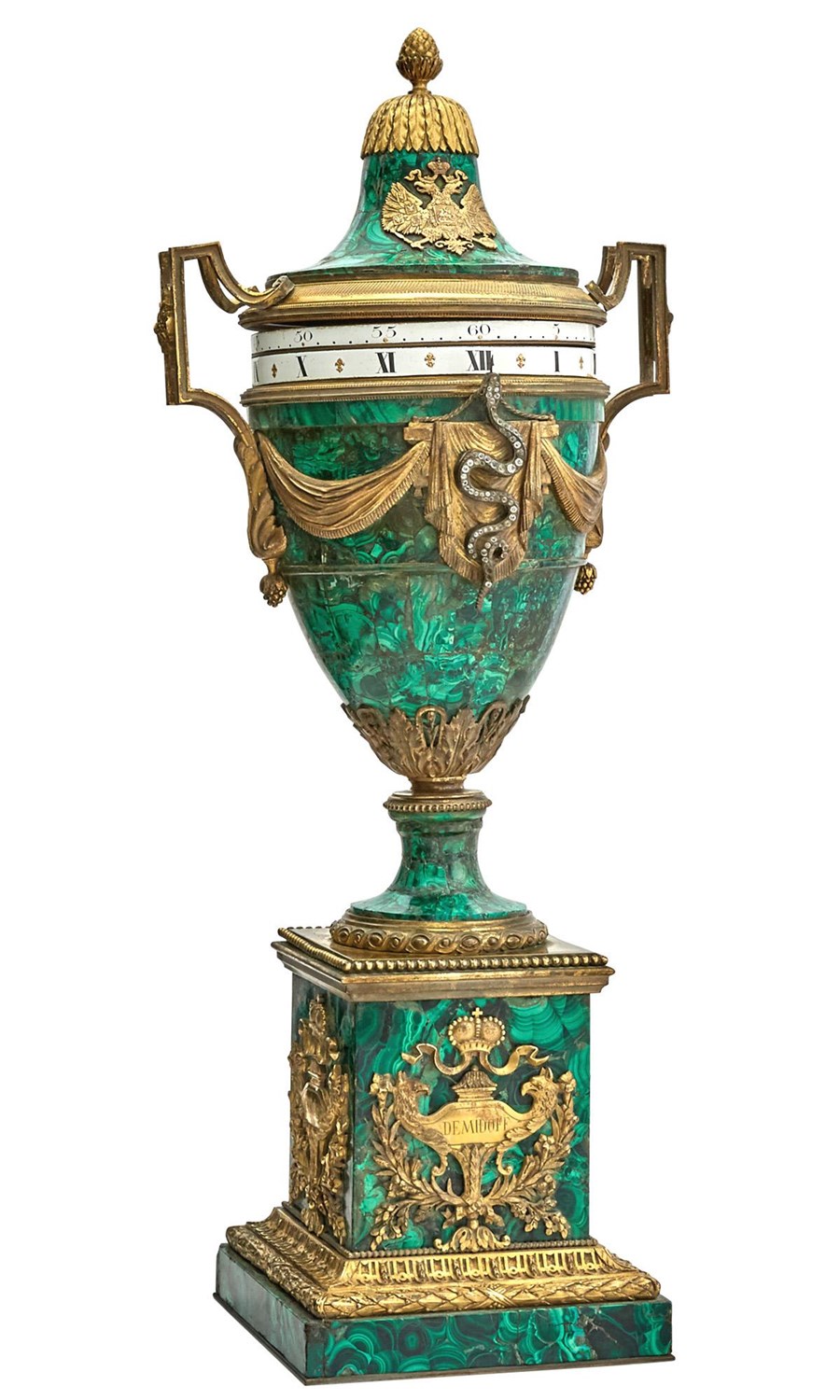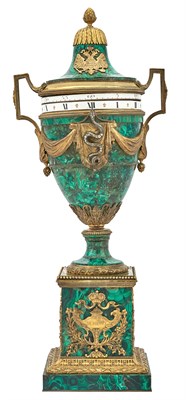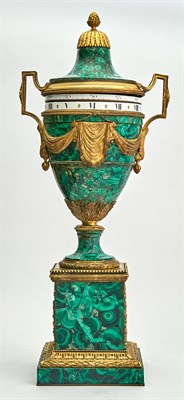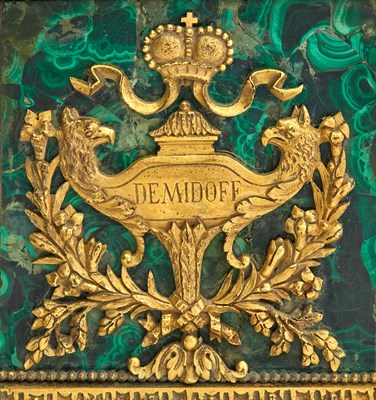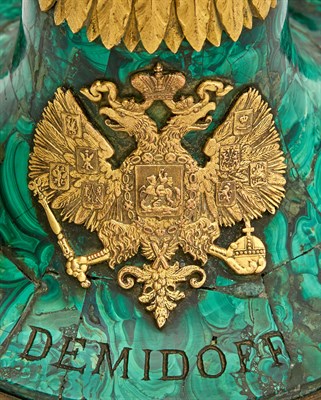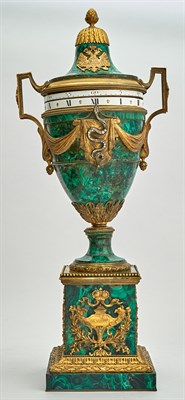May 23, 2023 10:00 EST
Faberge & Vertu / English, Continental & American Silver
46
Demidoff Family: Gilt-Bronze Mounted Malachite Revolving Dial Clock (Pendule à Cercles Tournantes)
French/Russian, Third Quarter 19th Century
Of urn form, with enamel Roman and Arabic chapter rings flanked by angular handles suspending a drapery swag mounted with a paste-set serpent pointing its tongue as the clock hand, with a removable domed cover with pine cone finial, applied with the Russian Imperial coat of arms and engraved Demidoff, raised on a square pedestal base mounted on three sides with a plaque engraved Demidoff, flanked by griffins and surmounted by a crown, the movement stamped Japy Frères & Cie. / Gde Med. d'Honneur and numbered 05. Height 21 1/2 inches (54.6 cm).
Provenance:
Commissioned by Anatole Demidoff, Prince of San Donato (1813-1870) or Count Paul Pavlovich Demidoff, 2nd Prince of San Donato (1839-1885).
Charles Tyson Yerkes, Jr. (1837-1905).
Mary Adelaide Yerkes (1858-1911); sold Estate of the Late Mrs. Mary Adelaide Yerkes, Principally Objects Retained from the Famous Collection formed by the Late Charles T. Yerkes, American Art Galleries, New York, February 19-21, 1912, lot 393.
Private Collection.
A gift to the family of the present owner, mid-20th century.
Literature:
L. Budrina, "Magnificent Surtout de Table (1822-1824) by Order of N.N. Demidov" [Velikolepnyi Sourtout de Table (1822-1824) po zakazu N.N. Demidova]. Star of the Renaissance [Zvezda Renessansa], No. 26-27, 2018, pp. 196-213.
L. Budrina, "The strategy of a new material: The Demidoff family and malachite." Researching Art Markets: Past, Present and Tools for the Future, 2021, pp. 182-193.
One of Imperial Russia's wealthiest families, the Demidoffs made their fortune in the eighteenth century in the manufacture of weapons and the establishment of an iron foundry for the government. Future generations of Demidoffs increased their inherited wealth by the discovery and operation of gold, silver and copper mines in the Ural Mountains and by the discovery on their estates of seams of malachite. The Demidoff name became closely associated with malachite and the works of art which made use of the material. One notable example is a monumental gilt-bronze mounted malachite vase made for the Demidoff family, with a pedestal and mounts by Pierre Philippe Thomire (1751-1843), which is now in the collection of the Metropolitan Museum of Art, New York (accession number: 44.152a, b).
The Demidoff malachite clock was made in Paris with malachite sourced in Russia in the third quarter of the nineteenth century. Since the early nineteenth century, the Demidoffs had supplied raw malachite to artisans, and its use became widespread in Paris during the Second Empire (1852-1870). There are numerous examples of works of art and furniture in malachite which were made from 1855 into the 1860s. The date of the Demidoff malachite clock is confirmed by the configuration of the Russian Imperial small coat of arms on its cover, which corresponds to the reign of Emperor Alexander II (1855-1881), and the stamp on the clock's movement, manufactured in Paris by Japy Frères & Cie, which was in use from 1867.
The date of the clock corresponds to the later years of Anatole Demidoff, the late 1860s until his death in 1870, when he resided in Paris. Anatole was born in Russia, raised in Paris, and spent most of his life in Western Europe. He worked as diplomat in Paris, Rome and Venice and acquired the Italian title of Prince of San Donato. A renowned patron of the arts, Anatole built on his father's own collection at the Villa San Donato in Florence, which was dispersed after his death in 1870.
If not commissioned by Anatole Demidoff, the clock likely was commissioned by his nephew Count Paul Pavlovich, 2nd Prince of San Donato. The first prince of San Donato recognized in the Russian Empire, Paul received permission in 1872 to use the Italian title in Russia. It is therefore plausible that the combination of decorative elements on the Demidoff clock (the Russian Imperial coat of arms together with the name of Demidoff and a princely crown) could have been made to commemorate this event. A date of manufacture after Anatole's death and a connection with Paul Demidoff would explain the absence of documentation of the clock in the sale of the Demidoff collection at the Villa San Donato, a large part of which represented Anatole Demidoff and earlier Demidoff acquisitions.
The Demidoff malachite clock appears to have been acquired in the late nineteenth or early twentieth century by Charles Tyson Yerkes, Jr., an American financier and prominent art collector. However, it is unclear exactly how and when it was acquired. The clock is recorded and illustrated in an auction catalogue of Yerkes' art collection, sold as part of the estate of his wife, Mary Adelaide Yerkes, at American Art Galleries in New York, February 19-21, 1912, as lot 392. A photograph of the clock (incorrectly numbered as lot 393), seems to be an exact match to the present lot. The auction catalogue also includes a pair of gilt-bronze mounted malachite tazzas (lot 394), engraved with the Demidoff name in Cyrillic. The tazzas are now in the collection of the Hillwood Museum, Washington, DC (cat. no. 21.100.2).
We would like to thank Dr. Ludmila Budrina, Associate Professor of Art History at Ural Federal University, Ekaterinburg, Russia, for her assistance cataloguing the present lot.
Sold for $34,375
Estimated at $20,000 - $30,000
Includes Buyer's Premium
Demidoff Family: Gilt-Bronze Mounted Malachite Revolving Dial Clock (Pendule à Cercles Tournantes)
French/Russian, Third Quarter 19th Century
Of urn form, with enamel Roman and Arabic chapter rings flanked by angular handles suspending a drapery swag mounted with a paste-set serpent pointing its tongue as the clock hand, with a removable domed cover with pine cone finial, applied with the Russian Imperial coat of arms and engraved Demidoff, raised on a square pedestal base mounted on three sides with a plaque engraved Demidoff, flanked by griffins and surmounted by a crown, the movement stamped Japy Frères & Cie. / Gde Med. d'Honneur and numbered 05. Height 21 1/2 inches (54.6 cm).
Provenance:
Commissioned by Anatole Demidoff, Prince of San Donato (1813-1870) or Count Paul Pavlovich Demidoff, 2nd Prince of San Donato (1839-1885).
Charles Tyson Yerkes, Jr. (1837-1905).
Mary Adelaide Yerkes (1858-1911); sold Estate of the Late Mrs. Mary Adelaide Yerkes, Principally Objects Retained from the Famous Collection formed by the Late Charles T. Yerkes, American Art Galleries, New York, February 19-21, 1912, lot 393.
Private Collection.
A gift to the family of the present owner, mid-20th century.
Literature:
L. Budrina, "Magnificent Surtout de Table (1822-1824) by Order of N.N. Demidov" [Velikolepnyi Sourtout de Table (1822-1824) po zakazu N.N. Demidova]. Star of the Renaissance [Zvezda Renessansa], No. 26-27, 2018, pp. 196-213.
L. Budrina, "The strategy of a new material: The Demidoff family and malachite." Researching Art Markets: Past, Present and Tools for the Future, 2021, pp. 182-193.
One of Imperial Russia's wealthiest families, the Demidoffs made their fortune in the eighteenth century in the manufacture of weapons and the establishment of an iron foundry for the government. Future generations of Demidoffs increased their inherited wealth by the discovery and operation of gold, silver and copper mines in the Ural Mountains and by the discovery on their estates of seams of malachite. The Demidoff name became closely associated with malachite and the works of art which made use of the material. One notable example is a monumental gilt-bronze mounted malachite vase made for the Demidoff family, with a pedestal and mounts by Pierre Philippe Thomire (1751-1843), which is now in the collection of the Metropolitan Museum of Art, New York (accession number: 44.152a, b).
The Demidoff malachite clock was made in Paris with malachite sourced in Russia in the third quarter of the nineteenth century. Since the early nineteenth century, the Demidoffs had supplied raw malachite to artisans, and its use became widespread in Paris during the Second Empire (1852-1870). There are numerous examples of works of art and furniture in malachite which were made from 1855 into the 1860s. The date of the Demidoff malachite clock is confirmed by the configuration of the Russian Imperial small coat of arms on its cover, which corresponds to the reign of Emperor Alexander II (1855-1881), and the stamp on the clock's movement, manufactured in Paris by Japy Frères & Cie, which was in use from 1867.
The date of the clock corresponds to the later years of Anatole Demidoff, the late 1860s until his death in 1870, when he resided in Paris. Anatole was born in Russia, raised in Paris, and spent most of his life in Western Europe. He worked as diplomat in Paris, Rome and Venice and acquired the Italian title of Prince of San Donato. A renowned patron of the arts, Anatole built on his father's own collection at the Villa San Donato in Florence, which was dispersed after his death in 1870.
If not commissioned by Anatole Demidoff, the clock likely was commissioned by his nephew Count Paul Pavlovich, 2nd Prince of San Donato. The first prince of San Donato recognized in the Russian Empire, Paul received permission in 1872 to use the Italian title in Russia. It is therefore plausible that the combination of decorative elements on the Demidoff clock (the Russian Imperial coat of arms together with the name of Demidoff and a princely crown) could have been made to commemorate this event. A date of manufacture after Anatole's death and a connection with Paul Demidoff would explain the absence of documentation of the clock in the sale of the Demidoff collection at the Villa San Donato, a large part of which represented Anatole Demidoff and earlier Demidoff acquisitions.
The Demidoff malachite clock appears to have been acquired in the late nineteenth or early twentieth century by Charles Tyson Yerkes, Jr., an American financier and prominent art collector. However, it is unclear exactly how and when it was acquired. The clock is recorded and illustrated in an auction catalogue of Yerkes' art collection, sold as part of the estate of his wife, Mary Adelaide Yerkes, at American Art Galleries in New York, February 19-21, 1912, as lot 392. A photograph of the clock (incorrectly numbered as lot 393), seems to be an exact match to the present lot. The auction catalogue also includes a pair of gilt-bronze mounted malachite tazzas (lot 394), engraved with the Demidoff name in Cyrillic. The tazzas are now in the collection of the Hillwood Museum, Washington, DC (cat. no. 21.100.2).
We would like to thank Dr. Ludmila Budrina, Associate Professor of Art History at Ural Federal University, Ekaterinburg, Russia, for her assistance cataloguing the present lot.
With a jeweled lever platform escapement, two train rack and snail movement striking on a bell. The movement stamped Japy Frères & Cie. / Gde Med. d'Honneur and numbered 05.Japy Frères & Cie was awared the Grande Medal d'Honneur at the Exposition Universelle in Paris in 1867. Date of clock: 1867-1887.In generally good condition, commensurate with age and use. Rubbing to gilding on bronze elements, with minor nicks and bruises to the edges. Gilt bronze ring above dial slightly bent. Some small chips to malachite veneer along edges and on corners. Some gaps between malachite tiles, visible especially on cover and on socle. Pointer/tongue of snake slightly bent. The clock is not currently running, but it is in working order. The works have been examined by an antique horologist.Please refer to additional photos and videos, which show the condition the clock in more detail.
Any condition statement is given as a courtesy to a client, is an opinion and should not be treated as a statement of fact and our Organization shall have no responsibility for any error or omission. Please contact the specialist department to request further information or additional images that may be available.
Auction: Faberge & Vertu / English, Continental & American Silver, May 23, 2023
